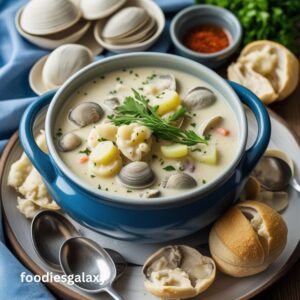New England Clam Chowder is a time-honored dish, beloved for its creamy texture and rich flavor. If you’ve ever wondered how to make this iconic soup, you’re in the right place. This guide will walk you through the entire process, from gathering the ingredients to the final, satisfying spoonful. Whether you’re an experienced cook or new to the kitchen, you’ll find this process straightforward and enjoyable.
So, let’s dive in and discover how to make a bowl of delicious New England Clam Chowder from scratch!
What Makes New England Clam Chowder So Special?
A Creamy, Comforting Classic
New England Clam Chowder is distinct for its rich, creamy base, which is a departure from the tomato-based version known as Manhattan Clam Chowder. The chowder typically features tender clams, creamy potatoes, crispy bacon, and aromatic vegetables. The balance of savory and slightly sweet flavors makes it a staple in New England cuisine and a favorite across the U.S.
One of the things that make New England Clam Chowder stand out is the simple yet satisfying combination of ingredients. It’s not overly complicated, but each component plays an essential role in contributing to the dish’s smooth, velvety texture and hearty flavor.
Key Ingredients You’ll Need
Gathering the Essentials
Before you begin cooking, it’s important to gather all the ingredients you’ll need. The process of making New England Clam Chowder involves a few key ingredients, most of which you may already have in your kitchen. Here’s what you’ll need to gather:
- Clams: Fresh clams are ideal, but if they aren’t available, canned or frozen clams will work just fine. The clams provide the salty, briny flavor that is the heart of the chowder.
- Potatoes: Waxier potatoes like Yukon Golds or Red Bliss are perfect for this dish. They hold their shape when cooked and lend a creamy texture to the chowder.
- Bacon: Bacon adds a smoky flavor that complements the other ingredients and provides a nice texture contrast to the soft vegetables and clams.
- Vegetables: Onions, celery, and garlic form the aromatic base of the chowder. These are sautéed at the beginning to release their flavors and provide depth to the dish.
- Cream or Milk: You can use heavy cream for an extra-rich chowder or opt for a lighter version with milk or half-and-half. The cream is key to giving the chowder its velvety texture.
- Herbs and Seasonings: Fresh thyme, bay leaves, and black pepper are typically used. You may also want to add salt to taste.
Having these ingredients ready will set you up for success and make the cooking process much smoother.
Preparing the Clams: The First Step
Clean and Cook the Clams
If you’re using fresh clams, start by preparing them. First, give them a good scrub under cold running water to remove any sand or debris on the shells. It’s important to discard any clams that are cracked or open, as they may not be safe to eat.
Once your clams are clean, place them in a large pot with a little water and heat them over medium-high heat. Allow them to steam until the shells open up, usually within 5-7 minutes. As they cook, the clams will release their flavorful broth. Once the clams are cool enough to handle, remove the meat from the shells and chop it into bite-sized pieces.
Set the clam meat aside, but don’t toss the broth! Strain the broth through a fine sieve to remove any grit, and save it for later—it’ll be used to add flavor to your chowder base.
Building the Chowder Base
Sautéing the Vegetables
Now that you have your clams and broth ready, it’s time to focus on the chowder base. Start by cooking the bacon. Dice the bacon into small pieces and cook it in a large pot over medium heat. Stir occasionally until the bacon becomes crispy and releases its fat. This will take about 5-7 minutes.
Once the bacon is done, remove it from the pot and set it aside, leaving a small amount of bacon fat in the pot. This will add a lovely smokiness to the chowder. Add the diced onions and celery to the pot, sautéing them until they soften and become fragrant. This usually takes around 5 minutes. If you’re using garlic, add it in after the onions and celery and sauté for another minute or so.
Cooking the Potatoes
Adding the Potatoes and Broth
Now it’s time to add the potatoes to the mix. Dice them into small, bite-sized pieces, ensuring they cook evenly. Add the potatoes to the pot along with the reserved clam broth. Pour in enough water to cover the potatoes completely. Bring the mixture to a simmer, and cook the potatoes until they’re tender, which should take about 10-15 minutes, depending on the size of the potato cubes.
As the potatoes cook, they will begin to release starch, helping to thicken the chowder. Make sure to check the potatoes by poking them with a fork; they should easily break apart when fully cooked.
Making the Creamy Base
Combining Cream and Seasonings
Once the potatoes are tender, it’s time to add the cream or milk. Pour in the heavy cream for a richer chowder, or opt for milk for a lighter version. Stir the mixture gently and bring it back to a simmer. Allow the soup to cook for an additional 5 minutes, letting the flavors meld together.
Next, season the chowder with fresh thyme, bay leaves, black pepper, and a pinch of salt. Keep in mind that the bacon and clams already add a certain level of saltiness, so be cautious with how much salt you add. Taste as you go to ensure the seasoning is balanced.
Bringing It All Together: Adding the Clams and Bacon
Final Steps for Perfection
Once the base is creamy and well-seasoned, it’s time to bring everything together. Add the chopped clams and crumbled bacon to the pot, stirring gently to combine. Allow the chowder to simmer for another 5 minutes, just to heat everything through and let the flavors develop.
After this, taste the chowder once more. If you feel it needs a little more seasoning, add salt and pepper as needed. Remove the bay leaves and thyme stems before serving.
Serving and Enjoying New England Clam Chowder
Garnish and Serve
Your New England Clam Chowder is now ready to serve! Ladle the soup into bowls, and if you like, garnish with a sprinkle of fresh parsley or more crispy bacon for added texture and flavor. Serve the chowder with oyster crackers or a slice of crusty bread on the side to soak up the creamy goodness.
Tips for Perfect New England Clam Chowder
Get the Most Out of Your Chowder
- Use Fresh Clams: Fresh clams make all the difference in flavor. If fresh clams are unavailable, canned or frozen clams will work well, but fresh clams will give your chowder a much richer taste.
- Don’t Overcook the Clams: Adding the clams too early or cooking them too long can make them tough and rubbery. Add them near the end of cooking and let them heat through without overcooking.
- Balance the Creaminess: The amount of cream you use is up to you. For a lighter version, use milk or half-and-half, but for a truly decadent chowder, heavy cream is the way to go.
- Let It Sit: Chowder often tastes better the next day as the flavors continue to develop. If you can, make it ahead of time and allow it to chill in the fridge overnight before reheating.
FAQs :-
1. Can I use canned clams instead of fresh ones for New England Clam Chowder?
Yes, you can use canned clams if fresh ones aren’t available. Just make sure to reserve the liquid from the can and add it to your chowder for extra flavor. However, fresh clams will provide a better taste and texture, so if possible, try to use them.
2. How can I make New England Clam Chowder lighter?
To make a lighter version of New England Clam Chowder, use milk or half-and-half instead of heavy cream. You can also reduce the amount of bacon or skip it entirely, replacing it with smoked paprika or a splash of liquid smoke for flavor.
3. Can I freeze New England Clam Chowder?
While you can technically freeze clam chowder, the cream-based soup may separate when thawed, affecting its texture. If you do freeze it, be sure to reheat slowly and stir gently to re-emulsify the chowder. For the best texture, it’s recommended to enjoy it fresh.
4. What type of potatoes work best for New England Clam Chowder?
Waxy potatoes, like Yukon Golds or Red Bliss, are ideal for clam chowder because they hold their shape during cooking and contribute to the creamy texture. Avoid starchy potatoes like Russets, which tend to break down too much and can make the chowder overly thick.
5. How do I store leftover New England Clam Chowder?
Store leftover clam chowder in an airtight container in the refrigerator for up to 2-3 days. Reheat gently on the stove over low heat to avoid separating the cream. If reheating, be sure to stir often for an even temperature.
6. Can I make New England Clam Chowder ahead of time?
Yes, New England Clam Chowder tastes even better when made ahead! The flavors have time to meld together, and it’s a great dish for meal prepping. Simply store the chowder in the refrigerator and reheat it slowly when you’re ready to serve.
7. How do I thicken New England Clam Chowder?
If your chowder is too thin, you can thicken it by mashing some of the potatoes in the soup with a spoon or potato masher. Alternatively, you can create a thickening slurry by mixing equal parts flour and water, then adding it to the soup while it simmers.
8. Can I add other seafood to New England Clam Chowder?
Absolutely! While the classic recipe uses only clams, you can add other seafood like shrimp, scallops, or lobster for a more decadent chowder. Just be sure to add them near the end of cooking to avoid overcooking the seafood.
Thank you so much for taking the time to read our New England Clam Chowder guide! We hope you found the recipe easy to follow and that it inspires you to create this delicious, comforting dish at home. Your support means the world to us, and we’re grateful for your interest in our content. If you try the recipe, we’d love to hear how it turned out! Keep cooking and stay tuned for more tasty recipes. 😊
Warm regards,
[HIMANSHI]
[foodies Galaxy]

